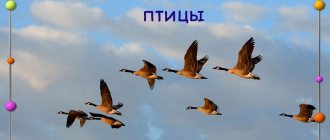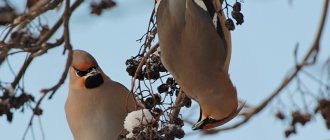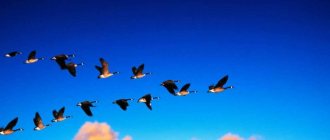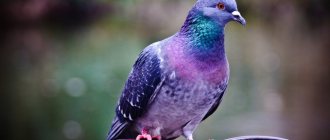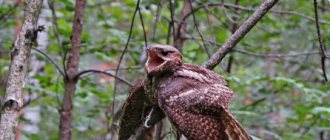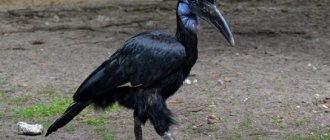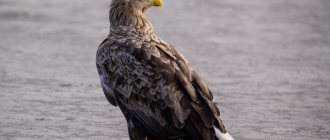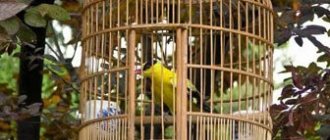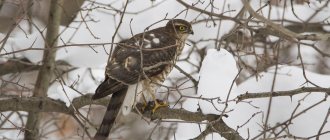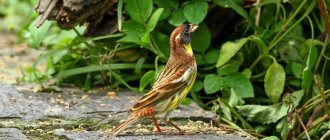Spread the love
The territory of the Leningrad region is quite rich in the diversity of flora and fauna. There are quite a variety of biotopes here that become habitats for various species. After all, some people prefer dense forests, while others need open spaces. In each of these areas you can find interesting species of feathered inhabitants, including birds of prey and famous singers. There is a wide range of bird species that live sedentary in these areas. The article will introduce the main species that can be observed in the Leningrad region.
Predator birds
Osprey (Pandion haliaetus)
The predatory feathered inhabitants of the Leningrad region include the osprey, which reaches a length of 60 cm, and its wingspan is about 1.5 m. The plumage is brown above, below, as well as in the area of the crown and back of the head, snow-white. A characteristic feature of the species are spots on the neck, which look like elegant beads. The brown stripe is located on the head. The legs and beak are dark. As a predator, the osprey is interesting because it primarily feeds on fish. She looks out for her prey while soaring over the water. Seeing the prey, the osprey interrupts its calm flight and abruptly rushes down to the surface of the water, plunges its legs under the water and catches fish, after which it rises into the air with the help of a powerful flap of its wings. Sometimes the osprey may also hunt rodents, small birds and mammals.
Gray owl (Strix aluco)
In deciduous and mixed forests you can meet such a feathered predator as the gray owl. Since this bird is well able to adapt to a wide variety of conditions, it sometimes becomes an inhabitant of city parks and gardens. The body length of the gray owl is about 40 cm, weight reaches 0.5 kg. This representative of the owl does not have “ears”. The wide, rounded wings are relatively short. The color is gray or brown, camouflage. These predators hunt birds and small mammals. It is quite difficult to spot a gray owl in the forest; it is much easier to hear it. The males make a long howling "oooooooh-oooooh" sound. Females communicate using a short voiceless “quiet”.
Short-eared owl (Asio flammeus)
Short-eared owls live up to their name, as they are found mainly in thickets along the banks of swamps, where these birds create their nests. A swamp can also replace a pond, the main condition being sufficient humidity in the bird’s habitat. Externally, the appearance of the short-eared owl is quite characteristic, owl-like. She has a dense body, reminiscent of a barrel, a pronounced facial disc, and her head is decorated with “ears”, short feathers collected in neat bunches. The plumage of the upper body is dark with rufous and white spots. The underparts are light, with rare noticeable spots of chocolate color. The length of the short-eared owl reaches 40 cm. As for the diet of this predator, it is unpretentious and willingly feeds on all types of animals and birds that it can catch in its habitat.
Order Ciconiiformes
Heron family – Ardeidae
4. Great bittern – Botaurus stellaris
5. Gray Heron – Ardea cinerea
6. White stork – Ciconia ciconia
Songbirds
Siskin (Carduelis spinus)
Siskin songbirds are well-known and popular for keeping at home. Their special squeaking voice is widely known, which is constantly heard in flocks of this species. In general, the vocalization of siskins is very diverse, it combines short syllables, beats and trills, into which the melodies of other species of birds, overheard somewhere by the siskin, are harmoniously interwoven. In the wild, siskins choose to live in coniferous forests, where they nest at the very tops of trees and practically do not descend to the surface of the earth. These crumbs barely reach 12 cm in length, weighing about 15 g. The plumage is emerald and golden, decorated with dark spots on top and yellowish below. The male has a head with a dark cap. The siskin feeds on both animal and plant foods.
Yellow-headed kinglet (Regulus regulus)
Throughout Russia, the wren is the smallest songbird. It grows only 10 cm in length, its wingspan is about 15 cm, and its weight barely reaches 10 g. The kinglet looks like a small fluffy ball, as it has a short neck and tail, and a large head. The kinglet is easy to recognize: its crown is decorated with a bright golden-amber stripe, which resembles a crown, and was the reason why the species was given such a name. And if the bird is excited or frightened, then these feathers rise up, forming a crest, and become very clearly visible. The body plumage of the kinglet is greenish on top, the belly is gray, and snow-white stripes are noticeable on the wings. In the forests you can often hear the characteristic singing of these little ones: thin squeaking high-pitched sounds “qi-qi” and melodic whistling trills “pri-tyut-pri-tyut-ee”.
Yurok (Fringilla montifringilla)
The migratory songbird that nests in the vastness of the Leningrad region is called the Yurok. Its vocalization sounds like a creaking chirp, at the end of which the sharp sound “zhzhzhzhzh” is always clearly heard. The single call of the bramble sounds like “keevk”, and during flights this singer now and then performs two-syllable sharp melodies “chi-vzhaya”. For life, this species of birds chooses mixed forests. The brambling is approximately the size of a sparrow. The plumage changes depending on the time of year. In summer, males are jet black with an orange breast. In winter, brownish color takes the place of black. The tail is white at the tip. Females are brown all year round with a yellowish breast.
Order Galliformes – Galliformes
Family Grouse – Tetraonidae
32. Black grouse – Lyrurus tetrix
33. Capercaillie – Tetrao urogallus
34. Hazel grouse – Bonasa bonasia
Forest birds
Green mockingbird (Hippolais icterina)
In damp deciduous forests, as well as in city parks of the Leningrad region, you can meet the green mockingbird. This migratory bird is small in size, with a graceful physique, a large head, a short tail and long wings. It reaches 15 cm in length. The plumage is quite bright: the belly is emerald with a yellow tint, the back is brown and greenish. Above the eyes there is a well-defined and visible “eyebrow” of yellow color. Mockingbirds practically do not descend to the ground, and periodically flutter out from the dense foliage of trees. They imitate other bird species with their songs. Only the call is different: loud, melodic, sounding like “chigriiii.”
Garden Warbler (Sylvia borin)
The length of the garden warbler is about 15 cm, weight reaches 20 g. The plumage is uniform, pale, the upper body is grayish-brown, with a slight emerald tint, and the lower parts of the chest, belly and undertail are snow-white feathers. There are no differences in the plumage of females and males of this species. And young animals are practically no different from adults, except perhaps a little paler. Garden warblers are numerous and widespread species of feathered inhabitants of forests of various types. They usually settle on the edges of the forest or near large clearings. Their diet consists of insects, and in the fall berries are added to it. As a migratory species for the winter, the garden warbler goes to African countries.
Common cuckoo (Cuculus canorus)
Another interesting inhabitant of the forests of the Leningrad region is the common cuckoo. Its dimensions are average, about 35 cm in length, with a wingspan of up to 65 cm and a weight of up to 200 g. The upper body of adult males is dark and gray in color. Throat with an ashy tint. The belly is snow-white, decorated with dark stripes. Females can be colored exactly the same as males, or they can have a completely special plumage: a red upperparts, a white belly and streaks throughout the body. In general, cuckoos are very secretive and silent birds. You can notice them in the forest only during the mating season, when the males begin to perform their famous songs, consisting of loud, measured, repeated sounds “ku-ku...ku-ku”.
Order Falconiformes – Falconiformes
Family Skopinae – Pandionidae
21-1. Osprey – Pandion haliaetus
21-2. Osprey in flight – Pandion haliaetus
Accipitridae family Accipitridae
22. Common honey buzzard – Pernis apivorus
23-1. Meadow Harrier , male – Circus pygargus
23-2. Meadow Harrier , female – Circus pygargus
24-1. Marsh Harrier , male – Circus aeruginosus
24-2. Marsh Harrier , female – Circus aeruginosus
25. Goshawk – Accipiter gentilis
26. Sparrowhawk – Accipiter nisus
27. Buzzard – Buteo buteo
28. Golden eagle – Aquila chrysaetus
29. White-tailed eagle – Haliaeetus albicilla
Falcon family – Falconidae
30. Merlin – Falco columbarius
31. Common kestrel – Falco tinnunculus
Resident birds
Black-headed Goldfinch (Carduelis carduelis)
The length of the black-headed goldfinch reaches 12 cm, weighs about 20 g. The plumage of this bird is very bright and attractive, as indicated by the name of the species itself. The front of the head is scarlet, the area of the back of the head and the crown of the head is coal-black, the cheeks are snow-white. The belly and chest are reddish-brown, the rump is snow-white. The wings are painted gold and generously decorated with spots of black and white. The black tail also has white spots at the tip. The reddish-white beak is black at the tip and has black whiskers at its base. Paws are yellow. Black-headed goldfinches live sedentary, in gardens, groves, and clearings. You can often see them flying from one tree to another, emitting loud cries as they do so. Goldfinches sing with ringing trills. They feed on insects and plant seeds.
Hooded Crow (Corvus cornix)
Crows are recognized as very smart birds with developed intelligence. Representatives of this species are characterized by a sedentary lifestyle, including in the Leningrad region. The hoodie is about 50 cm long, its wingspan reaches 1 m, and its weight is up to 1 kg. The bird is uniformly colored, gray with a black head, wings and tail. The physique is dense. The beak is strong and curved. It won’t be difficult even for a city dweller to recognize a hooded crow, since these birds often migrate to cities with the onset of winter cold. But they usually avoid people. The crow's voice is also characteristic - a hoarse croak.
Tree Sparrow (Passer montanus)
Another widespread sedentary species, the tree sparrow, differs from its house brother in that it is not so closely related to humans. Tree sparrows usually live in forests, fields and gardens, in abandoned villages. They differ from the house sparrow by the presence of a brownish cap on the head, black spots on light cheeks and a white collar. It reaches 15 cm in length. Tree sparrows live in flocks, in which it is practically impossible to distinguish males from females, or adult birds from young ones. Sparrows jump on the surface of the earth. The song is a sharp, dull chirp consisting of two syllables.
On the O-Prirode website you will find a lot of interesting information about birds and other animals of our planet.
Original earth-chronicles.ru
Conclusion
The geography of the region has an impact on the diversity of avifauna in these surroundings. Both the presence of a large metropolis - St. Petersburg, and a large number of adjacent cities and towns located in the Leningrad region, affects the comfort of existence of birds, providing the birds with the necessary nutritious diet and providing all the necessary conditions for their life.
All birds of this region can be divided into groups according to the natural areas in which they live:
- Forest
- Shrub areas
- Forest clearings
- Gardens/parks
- Vodoemov
- Protective plantings
- Rivers/lakes/swamps/seas
- Farmland
- Urban/rural
Himalayan monal (Lophophorus impejanus)
The Himalayan monal is a stunningly colorful bird endemic to the Himalayas. Males have a more colorful appearance than females. Their exceptionally beautiful plumage is a mixture of metallic blue, green, red and purple. The males of these birds also have noticeable metallic green feathers.
The female Himalayan monal does not have the stunning coloration of the males. They have the usual brownish plumage. Tufts on the head are also found in females, but they are small in size and brown in color.
Magpie
He bears not only the title of rattler and thief, but also the smartest bird. Only magpies recognize themselves in the mirror, not considering them to be other birds. Birds recognize people by their face and figure, like domestic dogs.
The magpies themselves are also not averse to being tamed. In captivity, birds learn to count and adapt to cleaning their cages. To do this, magpies use children's shovels, pieces of cardboard, and rags given to them by their owners. Magpies' intellectual abilities are attributed to the size of the cognition region in their brains. The area is as voluminous as that of a person.
While there were no scientific explanations for the mind of forty, mystical ones were selected. In the 19th century, for example, Metropolitan Alexei forbade white-sided people from approaching Moscow. The priest believed that witches flew to the capital under the guise of birds. Magpies feed on whatever they have to, and can both prey and consume vegetation. Omnivorousness and intelligence are a duet that allows magpies to survive even in harsh winters.
Magpies do not like to change their habitats and are even easily tamed by people
White Owl
She fell in love with the polar regions of Russia. Loose but abundant plumage helps them survive there. The air in it retains the heat of the owl's body, preventing cold from outside. The polar bird obtains prey with the help of silent and lightning-fast flight and acute vision. In the light of an ordinary candle, an owl sees its prey 300 meters away. The claws and beak of the predator catch hares, martens, rodents, and lemmings.
In years when food is poor, polar owls migrate to the forest-steppe zone. The bird is large, up to 70 centimeters in length. The bird gains 3 kilograms of mass. Harry Potter held about that much in his hand. The hero of JK Rowling's work often used the services of Boucli. That was the name of the white owl who served as a messenger for the wizard.
Order Charadriiformes – Charadriiformes
Charadriidae family – Charadriidae
39. Lapwing – Vanellus vanellus
Snipe family – Scolopacidae
40. Blackling – Tringa ochropus
41. Fifi – Tringa glareola
42. Carrier – Actitis hypoleucos
43. Snipe – Gallinago gallinago
44. Woodcock – Scolopax rusticola
45. Great Curlew – Numenius arquata
Gull family – Laridae
46. Black-headed gull – Larus ridibundus
47. Herring gull – Larus argentatus
48. Common tern – Sterna hirundo
Fan-crowned dove (Goura victoria)
At 30 inches long and weighing up to 3.5 kg, the fan-crowned pigeon is the largest living pigeon species in the world. It is found in the lowland forests of New Guinea and Indonesia. The most noticeable feature of this dove is its impressive lace-like crest with white tips.
This beautiful pigeon also has blue-gray body feathers with maroon underparts and striking red eyes. Both males and females look almost the same. The only noticeable difference is the rather large size of the males. During the breeding season, male crowned doves perform a remarkable courtship ritual, displaying their crest and tail.
In what biotopes does lapwing prefer to live, and how does it behave in nature?
In some countries, the lapwing is called a gull - the resemblance is visible to the naked eye.
Colonies of lapwings can be observed in open areas abundantly covered with grass. This bird lives near swamps, in heather heaths, in corn or potato fields, in wet meadows and rice fields.
Most often, for comfortable living, lapwings require damp territories, but in some areas they feel great on dry soil.
After wintering, lapwings are among the first to arrive at nesting sites. These birds are most active during daylight hours. Lapwings are excellent flyers.
Lapwing nests are made in depressions in the soil.
Lapwings guard their territory, especially their nests, very jealously. On this basis, they often have clashes with other birds, and especially with crows.
Crows
A kind of parrot in Russian. Crows adapt well to captivity. Birds live in it for about 40 years. In nature, the average lifespan of a crow is 20 years. Among people, birds grasp speech skills, speaking no worse than macaws.
The intelligence of ravens, by the way, is comparable to the development of 5-year-old children. Birds solve the same logical problems. One of the indicators of intelligence is the way it protects nests. Crows throw stones at enemies, lifting them in their tenacious paws.
Birds are unpretentious when it comes to food; they eat grains, vegetables, and bread. Birds often destroy the nests of other birds. But the favorite delicacy of ravens is carrion. There is a lot of it in winter, because not all animals can withstand the cold. So the birds remain for the winter.
How gloomy crows are. Many people say so. The impression that the birds make is associated not so much with their black coloring, but with their frequent appearance in cemeteries. There crows look for carrion.
In modern cemeteries it is rare to feast on human bodies and, of course, not human bodies. But in the old days, when plague epidemics raged, criminals and the poor were not always considered necessary to bury, crows literally flooded the burial grounds.
Crows are one of the smartest birds, they are able to survive even harsh winters
Tufted tit
The name of this bird speaks for itself. Thanks to its striking black and white conical crest, the tufted tit is often called a grenadier or grenadier.
The height of representatives of the species is from 11 to 14 cm, and they weigh only 14 g. The color of the plumage of the tufted tit is brownish-gray in the upper part and yellowish-white below.
This is an exclusively European bird, living in coniferous forests in the north of its range, and in deciduous forests closer to the south.
Also worth noting is the second species of the tufted tit genus - the gray-crested tit. This inconspicuous gray bird with a tuft lives in the tropical rainforests of South and East Asia.
Nuthatch
The bird has a bluish back and a white belly. The sides of the bird are red with black stripes. The paws have curved sharp claws. With them, nuthatches dig into tree trunks, quickly and deftly moving along them. The bird is looking for hidden insects and their larvae. The nuthatch’s sharp, long beak allows them to get them in winter. The bird uses it to explore every crevice in the bark.
Nuthatches prefer to settle in oak forests. Where oak trees do not grow, birds choose parks with deciduous plantings. Nuthatches look for trees with hollows, settling in them. If the entrance to the house is wide, it is coated with clay. Nuthatches do this work in the warm season.
Nuthatches prefer to survive the cold by nesting in tree hollows.
Population and species status
Nowadays, although these birds have been studied, they are not sufficiently studied, while IUCN data states that the overall population of these birds is quite large and their future does not cause any concern. Despite this, Amur waxwings are currently included in the Red Book.
The decline in the total number of waxwings is associated with uncontrolled catching of birds when they fly to the northern provinces of China for the winter. The Chinese not only keep these birds as decorative birds, but also eat them in preparing various dishes.
Owl
Listed in the Red Book. The feathered species easily endures Russian winters, but cannot adapt to the decline due to the destruction of the taiga of its patrimony. However, eagle owls are capable of living in captivity. In zoos and private owners, birds lived up to 68 years. In nature, the age of an eagle owl is limited to 20 years. Like the snowy owl, the eagle owl hunts rodents, hares, and martens.
Birds catch them around the clock. The main activity occurs at night. During the day, eagle owls often sleep. Eagle owls swallow small prey whole. The birds first tear large victims into pieces that can fit down the throat. There have been recorded cases of eagle owls attacking young roe deer and wild boars. This indicates the impressive size of the birds.
Order Woodpeckers – Piciformes
Woodpecker family – Picidae
58. Spinner - Jynx torguilla
59. Zhelna – Dryocopus martius
60. Great Spotted Woodpecker – Dendrocopos major
61. Lesser Spotted Woodpecker – Dendrocopos minor
Kedrovka
The bird feeds on pine nuts. For them, the bird has a sublingual pouch. In it, the nutcracker carries about 100 nuts. The Russian taiga is rich in cedar trees, which means that the bird has no reason to fly away in winter. Some of the cones remain on the trees in winter.
We hide the nutcracker nuts that do not fit into the sublingual sac within a radius of 2-4 kilometers from the tree on which they ripened. In winter, supplies are buried in snowdrifts, and in summer in the ground. In Russia there is a monument to the nutcracker. It is located in Tomsk. The Siberian city is surrounded by cedar trees. Residents of the region know and love their inhabitant, admiring her all year round.
Sparrow
The group of wintering birds consists of several species. There are two people in Russia: urban and field. The latter is typical for rural areas. The total number of sparrows on the planet is close to a billion. Accordingly, one bird for 8 people.
Considering that birds feed on grains, this is a threat to the harvest. The People's Republic of China even carried out an action to destroy sparrows. Having found out that they could not fly for more than 15 minutes, people frightened the birds, preventing them from falling to the ground. Approximately 2 million individuals fell dead. However, in the absence of sparrows, locusts multiplied - another delicacy for birds. She ate the harvest instead of the birds.
Like pigeons, sparrows tend to choose one partner for life. At the same time, birds have hot blood. Instead of 41 degrees, the sparrow's body heats up to 44 degrees. This is typical for small birds. They lose energy faster. It’s interesting that a sparrow’s neck has twice as many vertebrae as a giraffe’s. It's a matter of the length of the fragments. Sparrows have flat ones.
Order Crane-like animals – Gruiformes
Crane family – Gruidae
35. Gray crane – Grus grus
Family Railidae – Rallidae
36. Crake – Crex crex
37. Moorhen – Gallinula chloropus
38. Coot – Fulica atra
Red-footed ibis
It is also called the Japanese ibis. The bird amazes with its extraordinary beauty: its snow-white plumage is emphasized by the red color of its legs and unfeathered head. It has a long black beak with a curved red tip. The ibis has a yellow ring around its eyes, which completes the image of this strange bird. In adults, a large crest consisting of narrow feathers is clearly visible. By the way, this snow-white appearance of the bird’s plumage is only in winter. By spring, in adults, the back of the head, neck, back, and crop become ash-gray, and in the fall after molting, they become light pink. It is believed that such seasonal variability in the color of this bird is directly related to changes in hormonal levels during the breeding season. In the Primorsky Territory, the red-legged ibis can currently be found extremely rarely; according to some data, this bird no longer nests on the territory of the Russian Federation.
Bird with a crest on its head, bunting-remez: description, photo
- Let's look at another representative of crested birds. This is a remez bunting, which in appearance resembles a sparrow. The size of the bird is 15 cm, and its weight is only 16-20 g.
- The bird is reddish-brown. There are white and red stripes on the body. The crest of this bird is small, but in males it is larger than in females. Thanks to its short, strong beak, the bird is able to easily clean grains.
- The oatmeal does not immediately feed the chicks dry food. Before feeding, she holds the food in her beak for some time, soaking it.
Where does he live?
- Bunting loves the open spaces of the north of the country, mainly in the steppe regions (Siberia, Far East).
- In summer it settles in swamps where shrubs grow, and also chooses swampy river valleys.
- With the onset of cold weather, birds are forced to fly to a warmer climate zone. These are areas of East Asia.
Bird with a crest: bunting
What does it eat?
- The main food of oatmeal is insects. The bird eats grain crops and berries.
How does it hatch chicks?
The bunting hides its nest well from uninvited guests on the ground, in a hole. Sometimes a bunting's nest can be seen on a bush. It looks like a bowl, which birds “construct” from the stems and leaves of cereals. Moss, lichen, horsehair, and animal hair serve as bedding for the nest. There are usually 4-5 eggs in a clutch. The shell of oatmeal eggs is white or gray. There are brown specks. Two weeks after the start of brooding, the chicks appear.
What does oatmeal look like?

